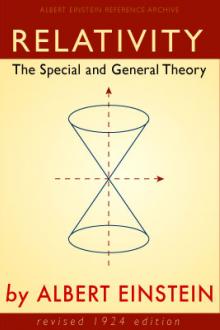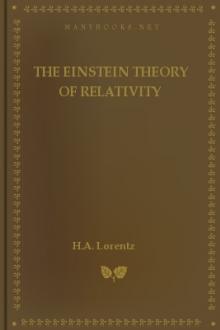Relativity - The Special and General Theory by Albert Einstein (early reader books txt) 📕

- Author: Albert Einstein
- Performer: 0452287847
Book online «Relativity - The Special and General Theory by Albert Einstein (early reader books txt) 📕». Author Albert Einstein
The Project Gutenberg EBook of Relativity: The Special and General Theory by Albert Einstein (#1 in our series by Albert Einstein)
Note: 58 image files are part of this eBook. They include tables, equations and figures that could not be represented well as plain text.
Copyright laws are changing all over the world. Be sure to check the copyright laws for your country before downloading or redistributing this or any other Project Gutenberg eBook.
This header should be the first thing seen when viewing this Project Gutenberg file. Please do not remove it. Do not change or edit the header without written permission.
Please read the “legal small print,” and other information about the eBook and Project Gutenberg at the bottom of this file. Included is important information about your specific rights and restrictions in how the file may be used. You can also find out about how to make a donation to Project Gutenberg, and how to get involved.
**Welcome To The World of Free Plain Vanilla Electronic Texts**
**eBooks Readable By Both Humans and By Computers, Since 1971**
*****These eBooks Were Prepared By Thousands of Volunteers!*****
Title: Relativity: The Special and General Theory
Author: Albert Einstein
Release Date: February, 2004 [EBook #5001] [Yes, we are more than one year ahead of schedule] [This file was first posted on April 1, 2002]
Edition: 10
Language: English
Character set encoding: ASCII
*** START OF THE PROJECT GUTENBERG EBOOK, RELATIVITY ***
ALBERT EINSTEIN REFERENCE ARCHIVE
RELATIVITY: THE SPECIAL AND GENERAL THEORY
BY ALBERT EINSTEIN
Written: 1916 (this revised edition: 1924) Source: Relativity: The Special and General Theory (1920) Publisher: Methuen & Co Ltd First Published: December, 1916 Translated: Robert W. Lawson (Authorised translation) Transcription/Markup: Brian Basgen <brian@marxists.org> Transcription to text: Gregory B. Newby <gbnewby@petascale.org> Copyleft: Einstein Reference Archive (marxists.org) 1999, 2002. Permission is granted to copy and/or distribute this document under the terms of the GNU Free Documentation License (end of this file) The Einstein Reference Archive is online at: http://www.marxists.org/reference/archive/einstein/index.htm
Transcriber note: This file is a plain text rendition of HTML. Because many equations cannot be presented effectively in plain text, images are supplied for many equations and for all figures and tables.
CONTENTS
PrefacePart I: The Special Theory of Relativity
01. Physical Meaning of Geometrical Propositions 02. The System of Coordinates 03. Space and Time in Classical Mechanics 04. The Galileian System of Coordinates 05. The Principle of Relativity (in the Restricted Sense) 06. The Theorem of the Addition of Velocities employed in Classical Mechanics 07. The Apparent Incompatability of the Law of Propagation of Light with the Principle of Relativity 08. On the Idea of Time in Physics 09. The Relativity of Simultaneity 10. On the Relativity of the Conception of Distance 11. The Lorentz Transformation 12. The Behaviour of MeasuringRods and Clocks in Motion 13. Theorem of the Addition of Velocities. The Experiment of Fizeau 14. The Hueristic Value of the Theory of Relativity 15. General Results of the Theory 16. Expereince and the Special Theory of Relativity 17. Minkowski’s Fourdimensial Space
Part II: The General Theory of Relativity
18. Special and General Principle of Relativity 19. The Gravitational Field 20. The Equality of Inertial and Gravitational Mass as an Argument for the General Postulate of Relativity 21. In What Respects are the Foundations of Classical Mechanics and of the Special Theory of Relativity Unsatisfactory? 22. A Few Inferences from the General Principle of Relativity 23. Behaviour of Clocks and MeasuringRods on a Rotating Body of Reference 24. Euclidean and non-Euclidean Continuum 25. Gaussian Coordinates 26. The Space-Time Continuum of the Speical Theory of Relativity Considered as a Euclidean Continuum 27. The Space-Time Continuum of the General Theory of Relativity is Not a Eculidean Continuum 28. Exact Formulation of the General Principle of Relativity 29. The Solution of the Problem of Gravitation on the Basis of the General Principle of Relativity
Part III: Considerations on the Universe as a Whole
30. Cosmological Difficulties of Netwon’s Theory 31. The Possibility of a “Finite” and yet “Unbounded” Universe 32. The Structure of Space According to the General Theory of Relativity
Appendices:
01. Simple Derivation of the Lorentz Transformation (sup. ch. 11) 02. Minkowski’s FourDimensional Space (“World”) (sup. ch 17) 03. The Experimental Confirmation of the General Theory of Relativity 04. The Structure of Space According to the General Theory of Relativity (sup. ch 32) 05. Relativity and the Problem of Space
Note: The fifth Appendix was added by Einstein at the time of the fifteenth reprinting of this book; and as a result is still under copyright restrictions so cannot be added without the permission of the publisher.
PREFACE(December, 1916)
The present book is intended, as far as possible, to give an exact insight into the theory of Relativity to those readers who, from a general scientific and philosophical point of view, are interested in the theory, but who are not conversant with the mathematical apparatus of theoretical physics. The work presumes a standard of education corresponding to that of a university matriculation examination, and, despite the shortness of the book, a fair amount of patience and force of will on the part of the reader. The author has spared himself no pains in his endeavour to present the main ideas in the simplest and most intelligible form, and on the whole, in the sequence and connection in which they actually originated. In the interest of clearness, it appeared to me inevitable that I should repeat myself frequently, without paying the slightest attention to the elegance of the presentation. I adhered scrupulously to the precept of that brilliant theoretical physicist L. Boltzmann, according to whom matters of elegance ought to be left to the tailor and to the cobbler. I make no pretence of having withheld from the reader difficulties which are inherent to the subject. On the other hand, I have purposely treated the empirical physical foundations of the theory in a “step-motherly” fashion, so that readers unfamiliar with physics may not feel like the wanderer who was unable to see the forest for the trees. May the book bring some one a few happy hours of suggestive thought!
December, 1916 A. EINSTEIN
PHYSICAL MEANING OF GEOMETRICAL PROPOSITIONS
In your schooldays most of you who read this book made acquaintance with the noble building of Euclid’s geometry, and you remember — perhaps with more respect than love — the magnificent structure, on the lofty staircase of which you were chased about for uncounted hours by conscientious teachers. By reason of our past experience, you would certainly regard everyone with disdain who should pronounce even the most out-of-the-way proposition of this science to be untrue. But perhaps this feeling of proud certainty would leave you immediately if some one were to ask you: “What, then, do you mean by the assertion that these propositions are true?” Let us proceed to give this question a little consideration.
Geometry sets out form certain conceptions such as “plane,” “point,” and “straight line,” with which we are able to associate more or less definite ideas, and from certain simple propositions (axioms) which, in virtue of these ideas, we are inclined to accept as “true.” Then, on the basis of a logical process, the justification of which we feel ourselves compelled to admit, all remaining propositions are shown to follow from those axioms, i.e. they are proven. A proposition is then correct (“true”) when it has been derived in the recognised manner from the axioms. The question of “truth” of the individual geometrical propositions is thus reduced to one of the “truth” of the axioms. Now it has long been known that the last question is not only unanswerable by the methods of geometry, but that it is in itself entirely without meaning. We cannot ask whether it is true that only one straight line goes through two points. We can only say that Euclidean geometry deals with things called “straight lines,” to each of which is ascribed the property of being uniquely determined by two points situated on it. The concept “true” does not tally with the assertions of pure geometry, because by the word “true” we are eventually in the habit of designating always the correspondence with a “real” object; geometry, however, is not concerned with the relation of the ideas involved in it to objects of experience, but only with the logical connection of these ideas among themselves.
It is not difficult to understand why, in spite of this, we feel constrained to call the propositions of geometry “true.” Geometrical ideas correspond to more or less exact objects in nature, and these last are undoubtedly the exclusive cause of the genesis of those ideas. Geometry ought to refrain from such a course, in order to give to its structure the largest possible logical unity. The practice, for example, of seeing in a “distance” two marked positions on a practically rigid body is something which is lodged deeply in our habit of thought. We are accustomed further to regard three points as being situated on a straight line, if their apparent positions can be made to coincide for observation with one eye, under suitable choice of our place of observation.
If, in pursuance of our habit of thought, we now supplement the propositions of Euclidean geometry by the single proposition that two points on a practically rigid body always correspond to the same distance (line-interval), independently of any changes in position to which we may subject the body, the propositions of Euclidean geometry then resolve themselves into propositions on the possible relative position of practically rigid bodies.* Geometry which has been supplemented in this way is then to be treated as a branch of physics. We can now legitimately ask as to the “truth” of geometrical propositions interpreted in this way, since we are justified in asking whether these propositions are satisfied for those real things we have associated with the geometrical ideas. In less exact terms we can express this by saying that by the “truth” of a geometrical proposition in this sense we understand its validity for a construction with rule and compasses.
Of course the conviction of the “truth” of geometrical propositions in this sense is founded exclusively on rather incomplete experience. For the present we shall assume the “truth” of the geometrical propositions, then at a later stage (in the general theory of relativity) we shall see that this “truth” is limited, and we shall consider the extent of its limitation.
Notes
*) It follows that a natural object is associated also with a straight line. Three points A, B and C on a rigid body thus lie in a straight line when the points A and C being given, B is chosen such that the sum of the distances AB and BC is as short as possible. This incomplete suggestion will suffice for the present purpose.
THE SYSTEM OF COORDINATES
On the basis of the physical interpretation of distance which has been indicated, we are also in a position to establish the distance between two points on a rigid body by means of measurements. For this purpose we require a ” distance ” (rod S) which is to be used once and for all, and which we employ as a standard measure. If, now, A and B are two points on a rigid body, we can construct the line joining them according to the rules of geometry





Comments (0)